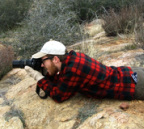The grasslands at American Prairie Reserve bustle with life. Whether it’s mourning dove air traffic, pronghorn vanishing over the horizon, or routine bison, mule deer, pronghorn, grouse, hawks, snakes, and prairie dogs, there’s always something to see.
However, every once in a while, we see something out of the ordinary.
My second day on the Reserve, we saw three badgers early in the morning. It’s funny because the day before, I told my crewmates my goal was to see at least one badger. You never hear anything about badgers, because they’re not a very popular animal. But there’s something about their mysterious, fossorial life that intrigues me, and this rare sighting piqued my interest even more.
Landmark crew member Shannon Rebinski caught the badgers on video:
Suddenly I had dozens of questions about their lives: How large are their home ranges? What do they eat? How do they disperse? But this was perfect; I could spend my free time reading about and researching how they live.
Turns out male badgers, as would be expected, have larger home ranges – an average of 7.6 square miles, whereas females, which aren’t as occupied with finding mates, range around 2.1 square miles, according to research from the University of Wyoming. Prairie dogs and ground squirrels are major prey items for these stout mustelids, and in areas of high prey concentration, badgers are territorial, so young establish home ranges separate of their mothers.
We investigated the perimeter of Manhattan a few days later and found a good number of badger holes, several of which had been used recently. We had several trail cameras not in use, so we devised a plan to set one out at the active holes to capture some badger behavior. After a week, we pulled the camera and found it had taken a video of a nocturnal badger!
Watch the trail camera video here:
Moral of this prairie story: Always be looking, because you never know what you’ll see or what will spark your interest.


